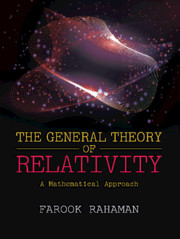Book contents
- Frontmatter
- Dedication
- Contents
- List of Figures
- List of Tables
- Preface
- Acknowledgments
- Chapter 1 Tensor Calculus — A Brief Overview
- Chapter 2 Geodesic
- Chapter 3 Einstein Field Equations
- Chapter 4 Linearized Gravity
- Chapter 5 Lie Derivatives and Killing’s Equation
- Chapter 6 Spacetimes of Spherically Symmetric Distribution of Matter and Black Holes
- Chapter 7 Particle and Photon Orbits in the Schwarzschild Spacetime
- Chapter 8 Causal Structure of Spacetime
- Chapter 9 Exact Solutions of Einstein Equations and Their Causal Structures
- Chapter 10 Rotating Black Holes
- Chapter 11 Elementary Cosmology
- Chapter 12 Elementary Astrophysics
- Appendix A Extrinsic Curvature or Second Fundamental Form
- Appendix B Lagrangian Formulation of General Relativity
- Appendix C 3+1 Decomposition
- Bibliography
- Index
Chapter 9 - Exact Solutions of Einstein Equations and Their Causal Structures
Published online by Cambridge University Press: 24 March 2021
- Frontmatter
- Dedication
- Contents
- List of Figures
- List of Tables
- Preface
- Acknowledgments
- Chapter 1 Tensor Calculus — A Brief Overview
- Chapter 2 Geodesic
- Chapter 3 Einstein Field Equations
- Chapter 4 Linearized Gravity
- Chapter 5 Lie Derivatives and Killing’s Equation
- Chapter 6 Spacetimes of Spherically Symmetric Distribution of Matter and Black Holes
- Chapter 7 Particle and Photon Orbits in the Schwarzschild Spacetime
- Chapter 8 Causal Structure of Spacetime
- Chapter 9 Exact Solutions of Einstein Equations and Their Causal Structures
- Chapter 10 Rotating Black Holes
- Chapter 11 Elementary Cosmology
- Chapter 12 Elementary Astrophysics
- Appendix A Extrinsic Curvature or Second Fundamental Form
- Appendix B Lagrangian Formulation of General Relativity
- Appendix C 3+1 Decomposition
- Bibliography
- Index
Summary
Minkowski Spacetime
Exact solutions of Einstein equations mean that the spacetime metric, which satisfies the Einstein field equations with stress-energy tensor Tab
Now, we will study the causal structures of some exact solutions of Einstein field equations.
The most simple empty spacetime in general theory of relativity is Minkowski spacetime. This is actually the spacetime in special theory of relativity. Using the natural coordinates (x1, x2, x3, x4) on R4 = M (M = manifold), one can express the metric in the form
with the range of coordinates as -∞ < x1, x2, x3, x4 < ∞. In this spacetime, all the components of Riemann tensor, therefore, it is a flat spacetime. The vector offers a time orientation of this spacetime.
For the choice of spherical polar coordinates (t, r, θ, ϕ) where
the metric assumes the following form,
In these new coordinate system the ranges are
Here all the Christoffel symbols will not all vanish. However, due to flat spacetime, all the Riemann curvature components will vanish.
To know the structure of infinity in Minkowski spacetime is our next target. For this, we use the interesting representation of this spacetime proposed by Roger Penrose.
A two-dimensional diagram of the spacetime where the causal relations and infinity structure are depicted through the use of conformal transformations is known as the Penrose diagram. They are also called the conformal diagram.
Actually conformal is a methodological word related to the rescaling of size. The light cones could not be changed under conformal transformation. The metric on a Penrose diagram and the actual metric in spacetime are conformally equivalent. The conformal factor is selected in such a way that the whole infinite spacetime is converted into a finite size in the Penrose diagram.
Result: If any two metrics G and g are chosen from the same manifold M such that they are connected by a positive definite conformal factor Ω2(x) as
then the null geodesics with respect to the metric G are the same to the null geodesics with respect to the metric g and vice-versa.
Information
- Type
- Chapter
- Information
- The General Theory of RelativityA Mathematical Approach, pp. 219 - 260Publisher: Cambridge University PressPrint publication year: 2021
